When preparing and planning for a trip to Cuba, it’s important to think about your budget, the prices in Cuba and how you’re going to pay for things while travelling around this incredible island nation.
With the internet and wi-fi being scarce and a hassle to connect to (although, it is getting better), you must have your finances and your budget sorted out beforehand.
It’s not as easy to check your bank balance online, or acquire Cuban money as it is in other countries.

We travelled independently around Cuba for almost a month and I’m here to give you a full breakdown of what the best currency to bring to Cuba is, how much money to bring, how to get Cuban money, and how much you can expect to spend while visiting Cuba.
What is The Cuban Currency?
Before even figuring out how much cash you’ll need to bring to Cuba, it’s important to understand the Cuban money (there are two currencies) and the rates.
The National Peso (CUP)
This currency is what most of the local people are paid their salary in.
Using the National Peso, you can purchase smaller items and the “basics” that one needs. It’s important to realize that this isn’t the “Cuban people’s currency”, foreigners can use this money as well.
Here’s what you can buy with CUP:
- Rides in the local inter-city buses (which are jam-packed full, no room to breathe)
- Fruit and vegetables from the markets and side-of-the-road stands
- Street snacks such as popcorn and fried plantains
- Rides in a collectivo (shared) taxi
- “Peso” food such as pizza, ice cream, sandwiches, rice & bean meals, and other smaller meals (pork & rice, spaghetti)
- Fresh fruit juice
- Basic groceries and produce
The Cuban Convertible Peso (CUC)
This currency is used for “luxury” items and is the Cuban money you’ll mostly find yourself spending during your travels here.
Locals who earn this currency rather than the National Peso are typically those in tourism (casa owners, tour guides, taxi drivers, hotel staff, etc.)
Being a Cuban and earning CUC is ideal.
With just 1 CUC (after exchanging it into National Pesos), they can buy 25 rides on a bus, 25 fresh cups of juice, or some rice and beans. This is the currency everyone wants.
Keep this in mind when musicians or dancers ask you for a tip — your 1 CUC goes a long way in Cuba.
Here’s what you can buy with CUC:
- Meals at a sit-down restaurant
- Cocktails and beer
- Bottled water
- Tourist bus (Viazul) tickets
- Internet
- Hotels and casa particulares
- Scuba Diving, horseback riding, and other excursions
- Car and scooter rentals
- Anything you want to buy, you can with this currency
How to Tell The Difference Between CUC and CUP
The two currencies actually look quite similar so when you first arrive, familiarize yourself with them to avoid being ripped off.
The main difference is that CUC does not have any faces on the note. It also says “pesos convertibles” in the center of the bill. Like this:

CUP has faces of famous Cuban people and says “pesos” in the center of the bill. Like this:
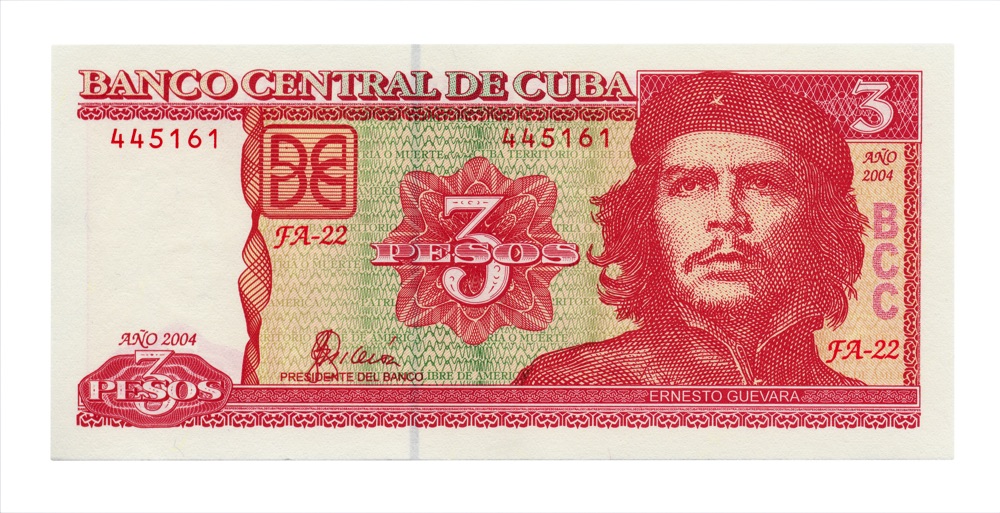
Always check your change to make sure that if you paid for something in CUC, you receive CUC back, (sometimes people will try to scam new travellers by giving them change in CUP, which is worth significantly less).
You can buy things that are normally charged in CUP with CUC and vice versa.
What is the Exchange Rate?
25 National Pesos (CUP) = 1 Cuban Convertible Peso (CUC)
1 Cuban Convertible Peso (CUC) = 1 US Dollar
Can I Use My Debit or Credit Card in Cuba?
If you have a debit or credit card issued by an American bank (ie: CitiBank), then it will NOT work in Cuba’s ATM machines.
If you have a bank card from any other nation, it should work at the ATMs, but a 3-12% fee will be charged with each transaction.
Even if you opened your account in your home country (ie: Canada), but the bank is affiliated or run by a US company (ie: CitiBank), your card will not work in Cuba.
Expect to spend cash when you’re in Cuba, rather than swiping your card.
Note: Make sure to inform your bank of your Cuba travel plans. If your account gets frozen while you’re abroad due to “suspicious activity”, it’ll be a hassle trying to connect with your bank back home to lift the hold on the account.
What Currency Should I Bring to Cuba?
Many people have asked us “How much cash should I bring to Cuba?” and “What currencies are accepted in Cuba?”
Well, if you’re not an American citizen and you don’t have a bank that’s affiliated with the USA, I would suggest having only a couple of hundred Canadian Dollars, Euros or Pounds on you as back-up funds.
Otherwise, you can use your debit and credit card at the machines in Cuba to withdrawal local currency (however, you will be charged 3% at the ATM, so it’s up to you as to whether or not you want to bring your full budget in cash and exchange it in-country).
Do NOT bring US Dollars to Cuba, as you will be charged a 10% conversion fee when you try to exchange into Cuban money.
Also, note that Australian dollars are NOT accepted. The best currencies to bring into Cuba to convert into Cuban money (CUC) are Canadian Dollars, Euros, Pounds and Mexican Pesos.
How To Exchange Money in Cuba
If you’ve travelled to Cuba with one of the accepted currencies (Canadian Dollars, Euros, Pounds, etc.), then you will need to exchange this currency into Cuban money — CUC.
So, where do you exchange your money?
Look for a CADECA, which are the money changers that are found in the cities. Line-ups can be long at these money changers, but it usually moves pretty quickly.
Make sure to bring your passport when exchanging money at a CADECA.
You’ll find a CADECA at the airport in Havana, or click here to find one in Havana on Google Maps.
The upside to withdrawing money from an ATM is that you won’t need to travel to Cuba with a bunch of cash on you, and then have a bunch of CUC once you exchange it at the CADECA.
The downside is that you’ll be charged between 3-12% by the ATM (we were charged 3% by the machine using Canadian bank cards).
How Much Money Should I Bring to Cuba?
If you’re American, and you’re wondering how much spending money you’ll need in Cuba, this will depend entirely on your travel style.
Your personal travel budget for Cuba might differ from ours, so check out the prices in Cuba for various activities (information below), and figure out how much you think you’ll need — it’s always better to err on the side of caution and have too much money, than not enough.
Our daily average in Cuba was $100/day for two people.
Remember, you’ll want to bring cash in the form of Pounds, Euros or Canadian Dollars, which you can get beforehand at your local bank at home.
Read on to see how much we spent, and what everything costs in the country.
How Much Does Cuba Cost?
People often ask us “Is Cuba expensive?” Cuba is very strange in that (depending on how you choose to travel) it can be one of the cheapest travel destinations in the world or one of the most expensive.
For the sake of simplicity, prices in this article are in CUC / USD (they’re equal), unless otherwise stated.
Here’s a breakdown of some of the prices in Cuba.
Cost of Accommodation in Cuba
$20 – $30 / night for a double room in a casa particular. Solo travellers can get a discount.
$25 – $180 + / night for a hotel room.
For authentic Cuba travel, Casa Particulares are the way to go!
If you’re wondering where to stay in Cuba for cheap, this is it. Casas are affordable, comfortable and you will enjoy a more local stay while in the country.
This is the best way to get to know the locals — feel free to chat with them about their life in Cuba, and practice your Spanish!
The food served by the casa owners is also very good. I highly recommend eating at least a meal or two at your casa particular.
Read more: What is a Casa Particular? All You Need to Know, with Video
Check out this video where we give you a tour of a casa so you can see what it’s like.
I recommend booking your casas ahead of time because once you’re in Cuba, finding internet (or at least, a solid connection) can be a hassle and it’s expensive.
It’s best to have your accommodation sorted out ahead of time unless you’re prepared to wait in queue for internet.
These days, you can book casas on Airbnb. Click here for a list of the top casas, guesthouses, villas, apartments and more in Cuba. Or, if you’d rather book hotel stays in Cuba, click here for a list of the best on Booking.com.
Another option is to just show up at each city and look around without booking ahead. Many casa owners will greet you at the bus station and offer you a room. But still, it’s best to book ahead so you can read reviews and have it all sorted out beforehand.
Cost of Food & Drink in Cuba
The prices in Cuba for a meal out varies greatly. Some cities are cheaper than others, such as Camaguey, while some are much more expensive. The cost of alcohol varies as well depending on where you choose to drink.

Cocktails at your casa are often cheaper than at a bar. Expect to spend $2 for cocktails and $1 for a beer.
At a nicer restaurant or bar, cocktails and beer are often similar in pricing, $2 – $3 each. Go for a mojito, trust me, you’ll love it!
Bottled water is what you need to watch out for. It’s hot in Cuba and you’ll want to make sure you stay hydrated. The cost of a 1.5L bottle should be $0.70, however, most shops charge tourists $1.50.
Shop around until you find the real price, or better yet, just hand them $0.70 and act like you know what it should cost. Also, some casas have potable water and juice for free. Just ask.
Better yet, bring a reusable water bottle and a SteriPen so you can purify the tap water and won’t have to use so much plastic during your travels to Cuba.
Here’s a chart showing some of the prices in Cuba for food — notice how cheap it can be!
RESTAURANTSPizza: $2.50 Tapas: $1.50 – $3.00 each Beef stew with rice and salad: $8 Spaghetti: $5.50 Fish in sauce with rice and salad: $9 Lobster/fish with sides at a restaurant: $8-$10 Fish, pork or chicken meal at casa (too much food to finish): $7 – $10 |
PESO FOODEgg sandwich w/cheese: 9p ($0.36) Cheese pizza: 6p – 30p ($0.24-$1.20) Fresh fruit juice: 1 – 2p ($0.04 – $0.08) Ice cream cone: 1p ($0.04) Grilled pork & rice: 35p ($1.50) |
Check out our video where we sample peso food around Cuba!
Contrary to belief, the food in Cuba is pretty good! Don’t believe us? Check out our article about Cuban cuisine.
Cost of Attractions and Activities in Cuba
All of the museums, sites, and activities that you’ll want to partake in will be paid for in CUC.
For tours, I recommend booking them online beforehand so you don’t need to deal with the wifi in Cuba.
In Havana:
- Museo de la Revolucion (Museum of the Revolution): $8 entrance fee
2. Fortaleza de San Carlos de la Cabana (Fort of Saint Charles): $8 entrance fee
3. Museo de Bellas Artes: $8 entrance fee
4. Ride in a Classic Car down the Malecon: $25 for 30 minutes depending on your bargaining skills. A better idea is to book your Classic Car ride here, and enjoy 2 hours of cruising around Havana, with a cocktail — plus, you won’t have to deal with tourist pricing problems. Check out the 2 Hour Classic Car Tour here:
5. Walking Tour: $40/person. On this walking tour, you’ll discover the UNESCO listed Old Havana with a knowledgeable guide. At the end, you’ll enjoy an authentic local lunch. Click here for details, or check out the walking tour here:
For some really unique and eye-opening tours in Havana, check out this list of Airbnb Experiences with locals.
Costs in Other Cities
If you’re going to pay for some tours in-country, here’s what you can expect to pay.
Viñales: Horseback riding tour – $25 for a 4-hour trip
Viñales: Santo Tomas Cave – $10 entrance fee (with guide)
Trinidad: Horseback riding tour – $15 for a 3-hour trip
Cayo Jutias: One tank scuba dive, including equipment – $40
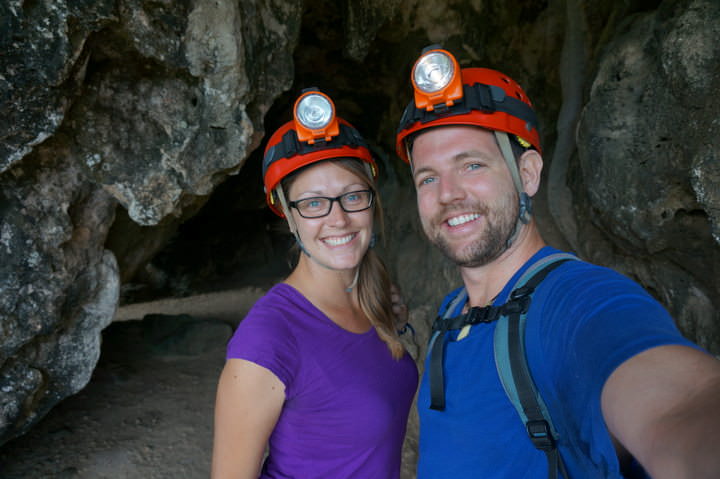
Cubans can enter museums and other attractions using the National Peso. For example: If it’s 5 CUC for foreigners to get in, it’s 5 CUP for locals ($5 vs $0.20).
This is one situation where it feels like there is a currency for foreigners and a separate currency for Cubans.
Although it truly is tourist pricing in this case, we do believe that if it weren’t this way, then many of the local people wouldn’t be able to visit the historic sites of their country.
Tourist pricing is a hot topic, something we’ve covered in length before, but we won’t get into that here.

Cuba Transportation Costs
Transportation in Cuba is comfortable and reliable, and the options are plentiful. The cost of transport varies with each city, and with all of the transport options I list below, make sure the price is per vehicle, not per person.
Here’s a rundown on the types of transport, and their costs:
Private Taxis: $2.50 – $7 for a journey within a city.
From the airport in Havana to Central Havana, the cost is $25 for a taxi.
An intercity, 60 minute private taxi costs around $30. Cuba taxi prices are quite high compared to other modes of transportation and although taxis have meters in them, they won’t be turned on. Arrange a price before you get in.
Shared Taxis (Collectivos): $0.50 / ride in the city (paid with 10 CUP. Don’t pay with CUC)
In Havana, very old classic cars run up and down various streets, on a set route. They will pull over and pick up people who are going in their direction, but you must flag them down. If you don’t know the route, this can be confusing.
You can also take shared taxis in between cities for (often) the same cost as the bus. From Trinidad to Havana, the cost is $25 / person. Ask at the Infotur offices for more details, or at your accommodation.
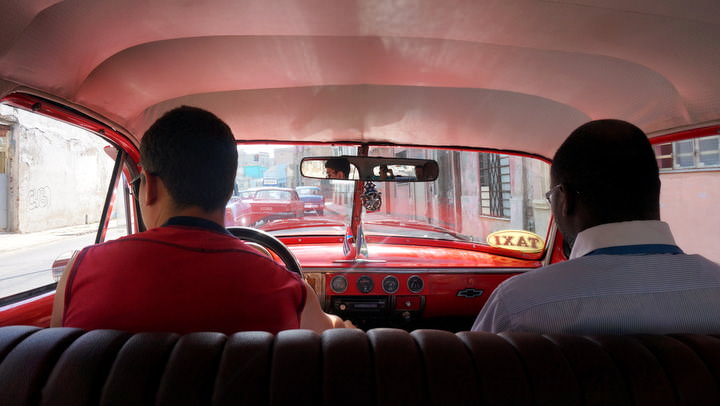
City Bus: $0.04 (yes, 4 cents!)
This transportation is very cheap, but the buses are packed to the brim with people. If you know the route and where you want to go, this is a good option.
Astro Bus: (generally around 1/2 the price of a Viazul bus)
This is the regular choice for intercity buses in Cuba. The prices of the Astro are cheaper than the Viazul below, however, there are only a few seats reserved for foreigners, the buses aren’t as new, and they aren’t as reliable.
Note: locals pay in CUP, while tourists pay in CUC.
Viazul Bus: $4 – $5 / hour
This is the tourist bus, which has air conditioning and runs on a reliable schedule. Some sample costs:
Havana to Viñales: $12
Havana to Varadero: $10
Havana to Trinidad: $24
Viñales to Cienfuegos: $35
Viñales to Trinidad: $37
Cienfuegos to Trinidad: $6
Trinidad to Camaguey: $15
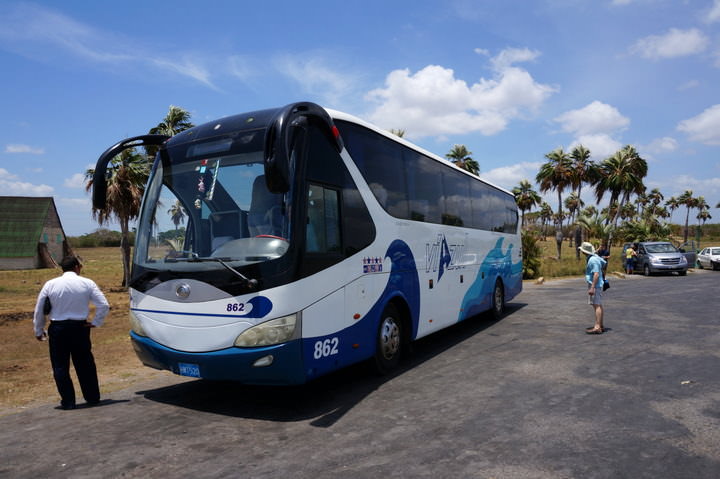
Cycle Taxi: $1 – $3 (depending on your bargaining abilities)
This is one mode of transportation where we always felt bad for the poor guy who had to cycle our big butts around in 35-degree heat! Bargain with the cycle drivers, but remember that this is a very hard job.
Scooter: $25 / day ($20 if you rent for 3 days)
This is the best way to get around in our opinion…especially in Viñales!
Check out our video of us scootering around Viñales!
Total Daily Cuba Budget
After spending 25 days in Cuba, we spent $2,500, including accommodation, tours, food, in-country transport…everything.
That’s $100 / day for two people.
However, I have to say that we lived pretty well while we were in Cuba as it was our vacation from blogging and being online. It would be possible to travel here for less if you ate more peso food, and took the local transportation, rather than Viazul buses.
We did stay in casa particulares, we often ate peso food, we limited the number of entrance fees we paid, and we took many cycle taxis.
However, we did drink mojitos and beers on the regular, ate good food and did a few activities (scuba diving, horseback riding, and caving). We also rented a motorbike in Viñales.
I think that $100 / day for two people to travel around an incredible Caribbean island is worth every penny! But, as I said before, your travel budget will differ from ours.
I recommend booking your tours and accommodation ahead of time before arriving in Cuba, and then use the cash for food, booze, entrance tickets, bus tickets, tips, souvenirs, etc.
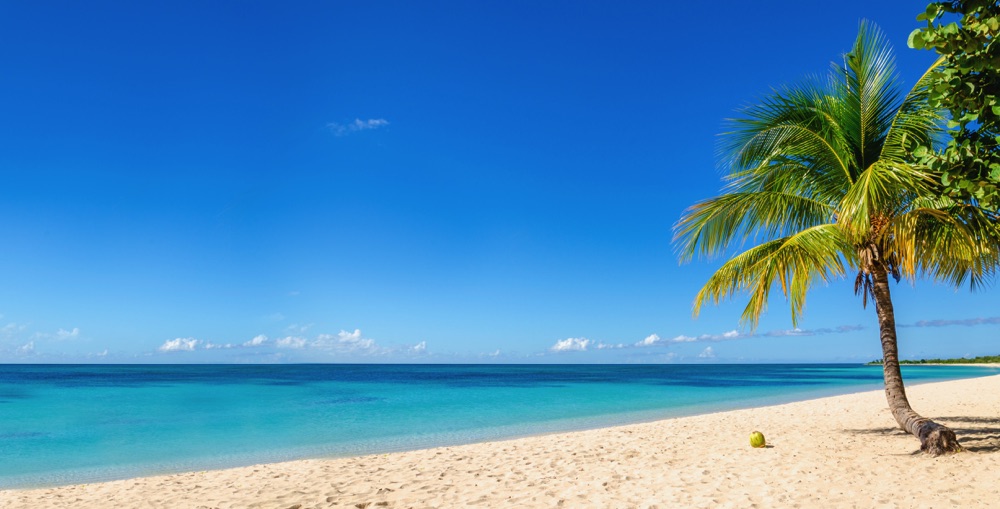
Now You Know The Prices in Cuba
There you have it. When it comes to travelling Cuba, even though it’s not as straight forward as other countries, it’s worth every minute of extra travel planning time!
I hope this article helped you plan your Cuba budget and that I was able to shed some light on the (confusing) Cuban currency as well. Happy travels!
Note: Some of the images in this post are courtesy of Shutterstock. Check them out for royalty-free photos and videos, here.
Like This Article? Pin it!


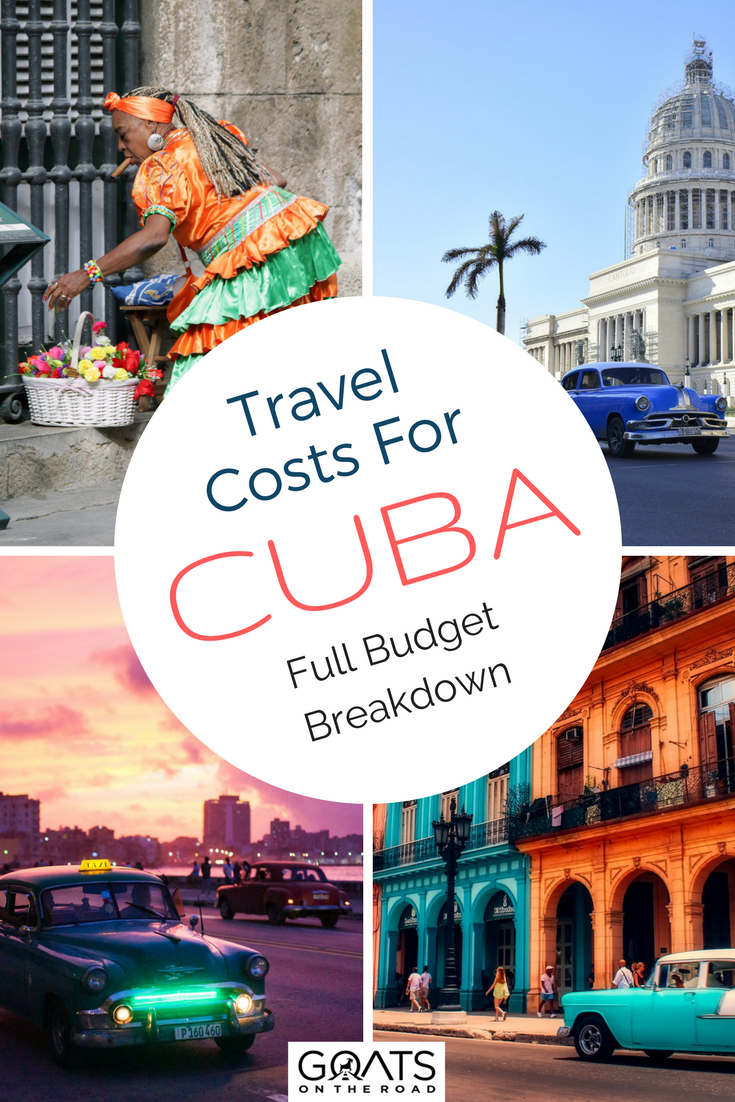
The post Cost Of Travel in Cuba: A Full Budget Breakdown appeared first on Goats On The Road.
from Goats On The Road https://www.goatsontheroad.com/travelling-to-cuba-what-does-cost/
VietNam Travel & Food Magazine Vina.com offers News✅ Travel info✅ Food Recipes✅ Photos✅Restaurant Guide at Vina.com https://vina.com/travel/nightlife/ https://vnfoodandtravelblog.blogspot.com/



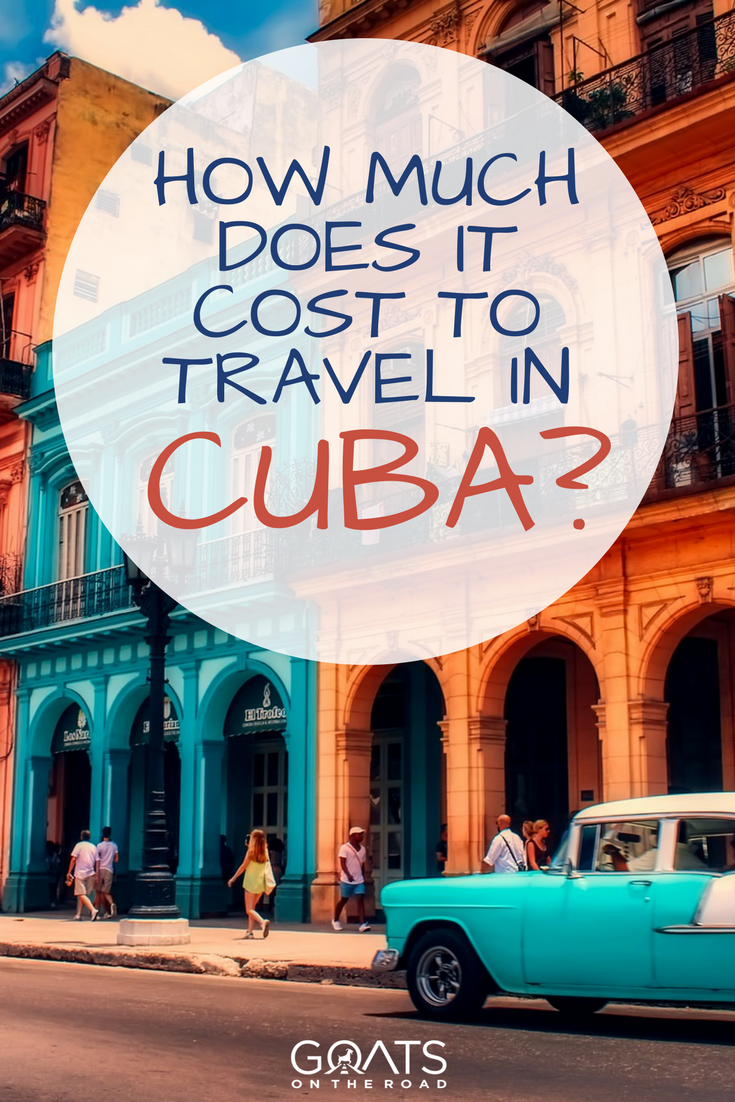
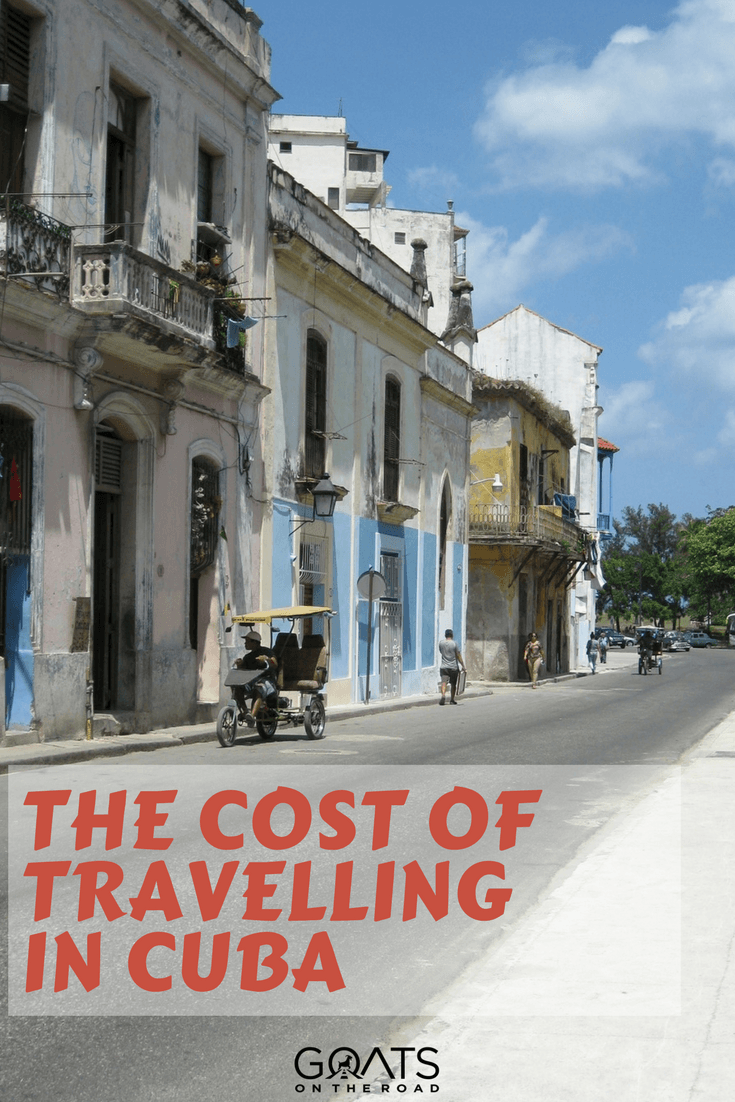
0 Nhận xét